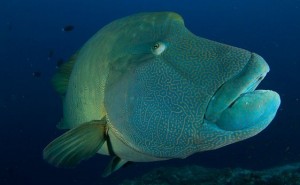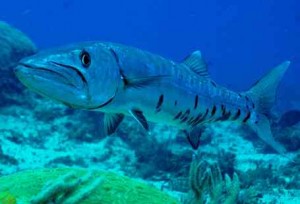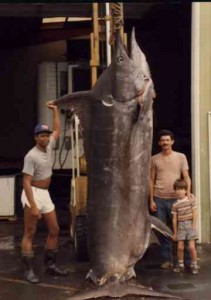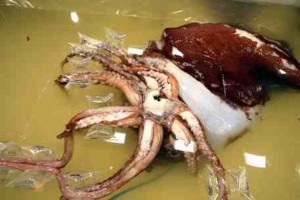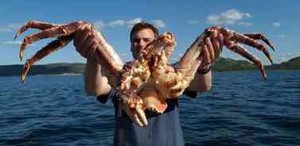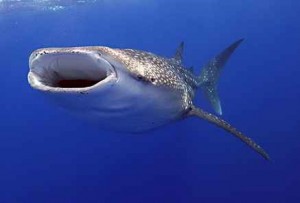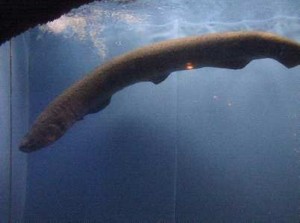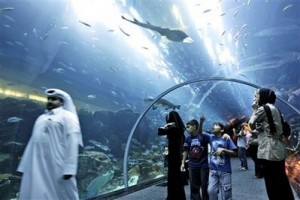
By ADAM SCHRECK, Associated Press Writer Adam Schreck, Associated Press Writer – Thu Feb 25, 11:55 am ET
DUBAI, United Arab Emirates – Water gushed from a leak in a shark-filled aquarium in a ritzy Dubai mall on Thursday, sending startled shoppers scattering and shutting down nearby shops in one of the city’s proudest attractions.
Amateur video footage posted on the Web site of Dubai newspaper Gulf News showed what appeared to be hundreds of gallons of water showering down on the polished tiled floor of the Dubai Mall, which sits in the shadow of the world’s tallest tower.
The timing is unfortunate for Dubai, which is trying to restore its once gilded image as it wades through a torrent of negative publicity generated by its burst property bubble, crippling debt pile and the assassination of a top Hamas commander in an airport hotel last month.
The incident also raises new questions about building safety in the city-state, which pushed through ever more extravagant and complicated construction projects until the economic downturn halted its rapid-fire growth. Less than three weeks ago, trapped tourists had to be pulled from a stuck elevator in the mall owner’s record-breaking Burj Khalifa skyscraper nearby. The world’s largest tower, due to accept its first permanent tenants in March, has yet to reopen to the public.
The breach in the 2.6 million gallon tank at the Dubai Mall, open little more than a year, was quickly plugged and caused no harm to the 33,000 fish inside, according to mall owner Emaar Properties. It was not clear when the attraction featuring an “underwater” tunnel would reopen.
Visitors were kept far from the scene shortly after the water began pouring from behind the 2-1/2 foot (0.75 meter) thick viewing panel, making it difficult to gauge the extent of the damage. From a distance, most of the water and fish appeared to be contained inside the tank.
Mahmoud Hamid, a spokesman for the sheikdom’s civil defense department, described the leak as “a small break in the glass” that maintenance crews were able to close later in the day.
Emaar confirmed the aquarium breach in a brief emailed statement Thursday afternoon.
“A leakage was noticed at one of the panel joints of the Dubai Aquarium at The Dubai Mall and was immediately fixed by the aquarium’s maintenance team,” the company said. “The leakage did not impact the aquarium environment or the safety of the aquatic animals.”
The company added that it “upholds the highest safety standards in its management.” It did not make anyone available to comment further.
Much of the area around the aquarium was evacuated and cordoned off. Three mall security employees were seen entering the area wearing orange life jackets.
An employee working for the offsite ticket office who did not provide his name said late Thursday that the aquarium would not reopen Friday. He said it was undergoing “maintenance” and was closed indefinitely.
Shopkeepers near the aquarium said they were ordered to close their stores and evacuate the area for fear of further flooding while the aquarium was repaired.
“They told me that the aquarium exploded,” an employee of a nearby shoe store that was ordered shut said on condition of anonymity, because she did not want to jeopardize her business. “We feel upset because it’s the end of the month and the start of the weekend and we were expecting many customers,” she said.
However, Alena Markovich, a manager of a clothing store that remained open for business Thursday, said the security response was swift and appropriate.
“They are doing their best,” she said.
The Dubai Mall and its signature aquarium opened in November 2008.
The shark, stingray and fish-filled tank is located on the mall’s ground floor, next to upscale clothing shops and not far from an Olympic-sized ice-skating rink and the only international branch of high-end retailer Bloomingdale’s.
The aquarium contains 2.6 million gallons (10 million liters) of water, and measures 164 feet (50 meters) across and 36 feet (11 meters) high. It boasts the world’s largest acrylic viewing panel.
Mall owner Emaar is also the builder of the neighboring Burj Khalifa.
The skyscraper has been closed to the public after visitors had to be pulled from the elevator shaft after one of the elevator cars got stuck. Emaar has not described the cause of the problem in detail, saying that “unexpected high traffic” and power supply problems were to blame.
Share on digg


